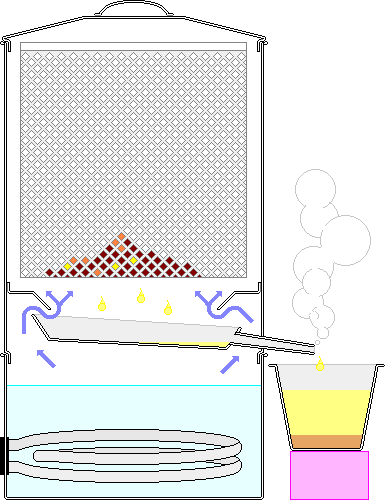Candle Making Index
Wax Melting
|
|
|---|
|
Candle Making Index Wax Melting |
Steam Wax Extractor |
|---|
The solar wax extractor is suitable for most beekeeper's needs and even with a fair number of colonies it will be adequate. The steam extractor is favoured by some and they have been used successfully for many years. There have been many designs, but in general the principle is the same as the one featured below. One of the most efficient I have come across is the "Wakeford Wax Extractor" that took the name of the Sussex beekeeper who designed it, George Wakeford. This was patented, but was poorly marketed - probably the main reason for its lack of popularity. It was advertised in BeeCraft in the 1960s at a cost of £4/10s post paid. I doubt if more than 50 were made, which is a pity. The design was simple, as it was effectively a box with a perforated tray the wax was put in. There was a steam diffuser in the lid. When time permits I will do a drawing in case anyone wishes to make them. I'm fairly certain there isn't one left in existance.
The Syston wax extractor that Dave Cushman writes about below hasn't been made for many years and to the best of my knowledge I have never seen one. I will leave this page for historical purposes, but the reading of it will explain the principles of this type of wax extractor.
Roger Patterson.
This device was designed and developed in the town that I live in, namely Syston, Leicestershire. According to T. W. Cowan it was originally designed by Professor Gerster and then modified by a Mr D. A. Jones, but I am unsure if this man is the one that lived in Syston.
|
It is a simple tool, it is very effective, and I can recommend it, having used one myself and having built several variants based on the same principles. It consists of a water chamber that is heated by gas or electricity, in order to boil the water and create the steam. Above this is a collector and spout arrangement that allows the molten wax and condensed steam to run out into a suitable vessel. (I have used pressed steel loaf baking tins that were Teflon coated for this purpose.) Immediately above the spout collector pan there is a skirt that deflects any molten wax into the collector, rather than dripping into the boiling water below. An upper chamber contains a mesh basket that holds the old comb or wax fragments that are to be melted. The assembly is topped by a close fitting lid that will not leak steam. Efficiency can be improved by lagging the metal skin of the extractor. Various filters or sieves may be fitted to the spout to catch any large fragments of cocoon that can sometimes get through. |

|
|---|
The way it works... When water is boiled at atmospheric pressure it heats up to 100° C and remains then at that temperature whilst each gram of water absorbs another 540 calories of energy (the latent heat of vaporisation). Only after this extra energy is supplied, does the water become steam. When steam comes in contact with cooler surfaces this latent heat is given up and in the case of the wax, causes it to melt. As the latent heat of fusion of beeswax is only 42 calories per gram there will be almost thirteen grams of wax melted for every gram of water that is turned to steam (minus the heat that is used to raise the wax from ambient to 63° C). This still leaves five or six times the wax melted for the steam generated. The melting is only at the outer surface of any block of wax and so most molecules of wax come into intimate contact with the water. Therefore any water soluble contaminant has a good chance of being dissolved in the run-off water that settles to the bottom of the collecting vessel and the steam at 100° C has a sterilising effect, so overall it is a fairly efficient process.
Another benefit of this process is that the wax cannot come into contact with anything that is above 100° C and so no discolouration can occur.
There is only one drawback with this equipment and that is the amount of water that is left in the beeswax. However it can be removed fairly easily the next time that the blocks are melted by using a melting method that keeps the wax out of contact with water... solar extractor, warming cabinet, hot air blower etc. Early removal of this entrapped moisture also aids the translucency of the wax.
The area that it is used in needs to be well ventilated as large amounts of steam will escape, apart from that which condenses and does the work.
The original design had a narrow cone of mesh up the centre of the wax basket to allow greater penetration of steam, but I have never used this feature myself.
Dave Cushman.
Page created 10/02/2002
Page updated 30/12/2022
Printed from Dave Cushman's website Live CD version
Written... 10 February 2002, Upgraded... 06 April 2006, Further Upgraded... 01 May 2008
|